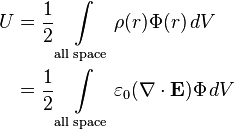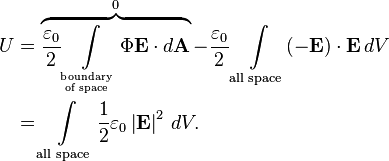Electric potential energy
| Electric potential energy | |
|---|---|
Common symbols | UE |
| SI unit | joule (J) |
Derivations from other quantities | UE = C · V2 / 2 |
| Electromagnetism |
|---|
 |
|
|
Electric potential energy, or electrostatic potential energy, is a potential energy (measured in joules) that results from conservative Coulomb forces and is associated with the configuration of a particular set of point charges within a defined system. An object may have electric potential energy by virtue of two key elements: its own electric charge and its relative position to other electrically charged objects.
The term "electric potential energy" is used to describe the potential energy in systems with time-variant electric fields, while the term "electrostatic potential energy" is used to describe the potential energy in systems with time-invariant electric fields.
Definition
We define the electric potential energy of a system of point charges as the work required assembling this system of charges by bringing them close together, as in the system from an infinite distance.
- The electrostatic potential energy, UE, of one point charge q at position r in the presence of an electric field E is defined as the negative of the work W done by the electrostatic force to bring it from the reference position rref[note 1] to that position r.[1][2]:§25-1[note 2]
 ,
,
- where E is the electrostatic field and ds is the displacement vector in a curve from the reference position rref to the final position r.
The electrostatic potential energy can also be defined from the electric potential as follows:
- The electrostatic potential energy, UE, of one point charge q at position r in the presence of an electric potential
 is defined as the product of the charge and the electric potential.
is defined as the product of the charge and the electric potential.
 ,
,
- where
 is the electric potential generated by the charges, which is a function of position r.
is the electric potential generated by the charges, which is a function of position r.
Units
The SI unit of electric potential energy is the joule (named after the English physicist James Prescott Joule). In the CGS system the erg is the unit of energy, being equal to 10−7 J. Also electronvolts may be used, 1 eV = 1.602×10−19 J.
Electrostatic potential energy of one point charge
One point charge q in the presence of one point charge Q

The electrostatic potential energy, UE, of one point charge q at position r in the presence of a point charge Q, taking an infinite separation between the charges as the reference position, is:
 ,
,
where  is Coulomb's constant, r is the distance between the point charges q & Q, and q & Q are the signed values of the charges (not the modules of the charges. For example, an electron would have a negative value of charge when placed in the formula). The following outline of proof states the derivation from the definition of electric potential energy and Coulomb's law to this formula.
is Coulomb's constant, r is the distance between the point charges q & Q, and q & Q are the signed values of the charges (not the modules of the charges. For example, an electron would have a negative value of charge when placed in the formula). The following outline of proof states the derivation from the definition of electric potential energy and Coulomb's law to this formula.
Outline of proof The electrostatic force F acting on a charge q can be written in terms of the electric field E as
 ,
,
By definition, the electrostatic potential energy, UE, of one point charge q at position r in the presence of an electric field E is the negative of the work done by the electrostatic force to bring it from the reference position rref to that position r.
 .
.
where:
- r = position in 3d space of the charge q, using cartesian coordinates r = (x, y, z), taking the position of the Q charge at r = (0,0,0), the scalar r = |r| is the norm of the position vector,
- ds = differential displacement vector along a path C going from rref to r,
 is the work done by the electrostatic force to bring the charge from the reference position rref to r,
is the work done by the electrostatic force to bring the charge from the reference position rref to r,
Usually UE is set to zero when rref is infinity:
so
When the curl ∇ × E is zero, the line integral above does not depend on the specific path C chosen but only on its endpoints. This happens in time-invariant electric fields. When talking about electrostatic potential energy, time-invariant electric fields are always assumed so, in this case, the electric field is conservative and Coulomb's law can be used.
Using Coulomb's law, it is known that the electrostatic force F and the electric field E created by a discrete point charge Q are radially directed from Q. By the definition of the position vector r and the displacement vector s, it follows that r and s are also radially directed from Q. So, E and ds must be parallel:
Using Coulomb's law, the electric field is given by
and the integral can be easily evaluated:
One point charge q in the presence of n point charges Qi


The electrostatic potential energy, UE, of one point charge q in the presence of n point charges Qi, taking an infinite separation between the charges as the reference position, is:
 ,
,
where  is Coulomb's constant, ri is the distance between the point charges q & Qi, and q & Qi are the signed values of the charges.
is Coulomb's constant, ri is the distance between the point charges q & Qi, and q & Qi are the signed values of the charges.
Electrostatic potential energy stored in a system of point charges
The electrostatic potential energy UE stored in a system of N charges q1, q2, ..., qN at positions r1, r2, ..., rN respectively, is:
|
|
(1) |
where, for each i value, Φ(ri) is the electrostatic potential due to all point charges except the one at ri,[note 3] and is equal to:
 ,
,
where rij is the distance between qj and ri.
Outline of proof The electrostatic potential energy UE stored in a system of two charges is equal to the electrostatic potential energy of a charge in the electrostatic potential generated by the other. That is to say, if charge q1 generates an electrostatic potential Φ1, which is a function of position r, then
Doing the same calculation with respect to the other charge, we obtain
This can be generalized to say that the electrostatic potential energy UE stored in a system of N charges q1, q2, ..., qN at positions r1, r2, ..., rN respectively, is:
 .
.
Energy stored in a system of one point charge
The electrostatic potential energy of a system containing only one point charge is zero, as there are no other sources of electrostatic potential against which an external agent must do work in moving the point charge from infinity to its final location.
Energy stored in a system of two point charges
Consider bringing a point charge, q, into its final position in the vicinity of a point charge, Q1. The electrostatic potential Φ(r) due to Q1 is
Hence we obtain, the electric potential energy of q in the potential of Q1 as
where r1is the separation between the two point charges.
Energy stored in a system of three point charges
The electrostatic potential energy of a system of three charges should not be confused with the electrostatic potential energy of Q1 due to two charges Q2 and Q3, because the latter doesn't include the electrostatic potential energy of the system of the two charges Q2 and Q3.
The electrostatic potential energy stored in the system of three charges is:
Outline of proof Using the formula given in (1), the electrostatic potential energy of the system of the three charges will then be:
Where
 is the electric potential in r1 created by charges Q2 and Q3,
is the electric potential in r1 created by charges Q2 and Q3,  is the electric potential in r2 created by charges Q1 and Q3, and
is the electric potential in r2 created by charges Q1 and Q3, and  is the electric potential in r3 created by charges Q1 and Q2. The potentials are:
is the electric potential in r3 created by charges Q1 and Q2. The potentials are:Where rab is the distance between charge Qa and Qb.
If we add everything:
Finally, we get that the electrostatic potential energy stored in the system of three charges:
Energy stored in an electrostatic field distribution
The energy density, or energy per unit volume,  , of the electrostatic field of a continuous charge distribution is:
, of the electrostatic field of a continuous charge distribution is:
Outline of proof One may take the equation for the electrostatic potential energy of a continuous charge distribution and put it in terms of the electrostatic field.
Since Gauss's law for electrostatic field in differential form states
where
-
 is the electric field vector
is the electric field vector -
 is the total charge density including dipole charges bound in a material
is the total charge density including dipole charges bound in a material -
 is the permittivity of free space,
is the permittivity of free space,
then,
so, now using the following divergence vector identity
we have
using the divergence theorem and taking the area to be at infinity where

So, the energy density, or energy per unit volume
 of the electrostatic field is:
of the electrostatic field is:
Energy in electronic elements

Some elements in a circuit can convert energy from one form to another. For example, a resistor converts electrical energy to heat; this is known as the Joule effect. A capacitor stores it in its electric field. The total electric potential energy stored in a capacitor is given by
where C is the capacitance, V is the electric potential difference, and Q the charge stored in the capacitor.
Notes
- ↑ The reference zero is usually taken to be a state in which the individual point charges are very well separated ("are at infinite separation") and are at rest.
- ↑ Alternatively, it can also be defined as the work W done by the an external force to bring it from the reference position rref to some position r. Nonetheless, both definitions yield the same results.
- ↑ The factor of one half accounts for the 'double counting' of charge pairs. For example, consider the case of just two charges.
References
| ||||||||||||||||||





 ,
,

















